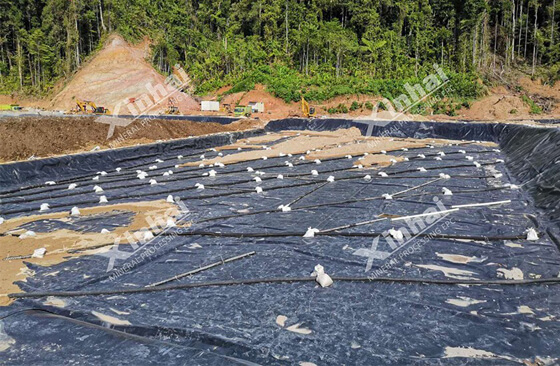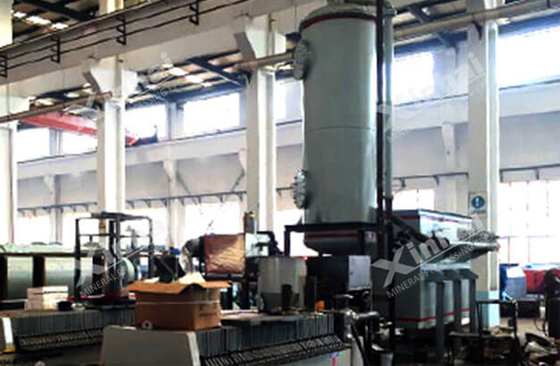

Warm Tip: If you want to know more details about equipment, solutions, etc, please click the button below for free consultation, or leave your requirements!
Pool leaching is an easy method for extracting gold. It has advantages of low investment, quick start-up, and low cost. It is suitable for processing iron oxide cap-type ores containing fine-grained gold and oxidized quartz veins containing fine-grained gold. This article will introduce 9 important processes of the gold ore pool leaching process.
The gold ore is coarsely crushed and finely crushed with a jaw crusher and a cone crusher to obtain a product with a discharge particle size less than 8mm. Due to the different nature of the ore, the particle size of the material required for the pool leaching is also different. In the Indonesia 700TPD Gold Mine Pool Leaching Project undertaken by Xinhai Mining Company, the ore is crushed to 5mm.

(Indonesia 700TPD Gold Mine Pool Leaching Project)
Before leaching, the pool must be built first. The quality of the pool is a key factor to ensure the success of the leaching. Therefore, the following 5 conditions must be met.
Condition1 The qualified immersion pool should be leak-proof and water-proof, with sufficient strength, and the bottom of the pool should be flat and smooth with a slope of -8%. The depth of the pool is 1.2 meters, and the volume is 15-20m³. The immersion liquid outlet pipe in the tank generally uses iron pipe or a plastic pipe with 1inch diameter.
Condition 2 The construction requirements of the pregnant liquid tank and the lean liquid tank are the same as the leaching tank, but the volume is 8-10m³.
Condition 3 When constructing the pool, lay a concrete layer (10-20 cm thick) on the bottom of the pool to prevent leakage of the pool. The walls of the pool are made of red brick and cement mortar with a thickness of at least 25 cm. The inner wall is plastered with high-grade fine mortar ( 2cm thick).
Condition 4 There must be a certain level difference between the leaching tank and the lean liquid tank. A 2-inch iron pipe is placed on one side of the leaching tank to lead to the lean liquid tank to facilitate liquid circulation and replacement.
Condition 5 Immersion pool, the pregnant and lean liquid pools should be 30cm higher than the surrounding flat ground to prevent floods from entering the pool.
Step1 First, lay a percolation layer on the bottom of the pool to filter the immersion liquid and prevent the mud from flowing out of the bottom of the pool into the precious liquid. The material of the percolation layer can be pebbles, coarse sand or coarse-grained ore blocks, and the layer thickness is 20-25cm.
Step2 Adopt dry method to fill the pool. Use a cart to load the crushed ore directly into the pool along one side.
According to practical experience, if the raw gold ore contains not much mud (<5%), it is best to crush the ore into the pool to a size less than 3mm. With the increase of the mud content of the raw gold ore ore, the particle size of the ore into the pool will increase accordingly to ensure the better permeability of the ore layer.
Factors such as the pH, concentration and the oxygen content of the cyanide leaching solution will affect the leaching efficiency.
Step1 After loading the ore into the pool, first add lime water to soak for 2-3 hours for pretreatment. When the pH value of the soaking liquid discharged from the bottom of the pool reaches 9, it can be leached with cyanide.
Step2 The concentration of cyanide leaching solution is generally controlled above 0.05%, and it is transported to the leaching tank with a centrifugal pump. The leaching liquid level must be 10cm higher than the ore layer, which can ensure that the ore can be completely immersed in the solution.
Step3 The amount of dissolved oxygen in the immersion liquid has a great influence on the dissolved gold. It is better to inflate into the immersion liquid.
Step4 The circulating immersion liquid can be used to accelerate the diffusion speed of cyanide, (dissolved) oxygen and gold complexes. The specific method is to discharge the immersion liquid from the immersion tank, and then use a submersible pump to lift the immersion liquid back to the immersion tank. It can be cycled once every 1 to 2 days.
Step5 The entire leaching process should be supplemented with cyanide and lime water in an appropriate amount according to the specific situation to supplement the consumption of cyanide and maintain the pH value of the leaching solution at 10-11. The leaching cycle is generally 10~15 days. If the gold content of the raw ore is high or the temperature is too low, it can be appropriately extended.

(Zinc powder replacement device)
Zinc replacement is a common process for extracting gold from pregnant. And it is more suitable for gold ore with high silver content than activated carbon adsorption method or resin adsorption method.
At the end of the leaching, the pregnant is discharged from the leaching tank for replacement of zinc powder or zinc flakes. The zinc flakes are put into the replacement tank, and the pregnant flows through the tank, and the gold is replaced by the zinc and attached to the zinc flakes.
In order to ensure the complete replacement of the gold in the solution, the precious solution can be repeatedly replaced 2-3 times. For each replacement, the contact time between the precious solution and the zinc flakes can be controlled within 15-20 minutes.
After zinc replacement process, the elution operation is performed to obtain the gold mud.
Step1 Wash to get gold mud. Put the gold-loaded zinc flakes in clean water to scrub, and the gold particles that are not firmly attached can be washed off the zinc flakes.
Step2 pickling to obtain gold mud. Put the washed gold-zinc flakes into an acid-resistant container, add a certain amount of water, and then slowly add sulfuric acid to control the acid concentration at 15-20%. Stir the zinc flakes to accelerate the shedding of gold particles.
Step3 See that the zinc flakes are off-white and stop pickling, immediately take out the remaining zinc flakes, rinse them in clean water, and return the zinc flakes for reuse.
Step4 When the zinc flakes are off-white, stop pickling, immediately take out the remaining zinc flakes, rinse them in clean water, and return the zinc flakes for reuse.
Remove zinc, copper, lead and other soluble impurities in the gold mud. Generally use dilute acid to heat to 70-80°C for treatment.
Silver is soluble in boiling concentrated sulfuric acid or soluble in nitric acid, while gold is insoluble. The two differences between gold and silver can be used to separate them.
The smelting of gold needs to add fluxes such as borax, soda, quartz sand, saltpeter, fluorite, magnesia, etc., in a box-type high-temperature electric furnace or earth coke furnace. The ratio of the flux depends on the composition of the gold powder. The smelting temperature can be controlled at about 1200°C and the constant temperature is 15-20 minutes.
Gold ore pool leaching including the 9 important processes:
Crushing raw ore
Building leaching pool
Putting ore into pool
Leaching
Replacing gold with Zinc
Eluting
Removing impurities
Separating gold and silver
Smelting
Pool leaching is very suitable for ore with a certain degree of oxidation and a long leaching time, such as iron oxide cap type ore containing fine-grained gold and oxidized quartz vein containing fine-grained ore gold ore. If you want to use the pool leaching process to extract gold, you must first determine the properties of the ore, and then determine the ore size, leaching solution concentration, leaching time and other parameters through the beneficiation test, and finally achieve a good recovery index.
If you want to know more information, or have any questions, welcome to leave a message to us or contact the online service.
Last: Resin Technology for Gold Extraction
Next: 3 Methods for Extracting Gold from Leaching Solution in Cyanidation Plant
1What Are The Gravity Separation Methods Used To Process Gold I?
 5
5
 4097
4097
2Difficulties and Solutions in Micro-fine Gold Extraction?
 0
0
 3534
3534


What Are the Differences Between CIP and CIL?
 11114
11114
 0
0